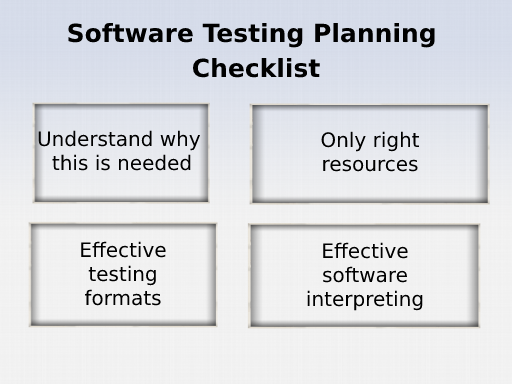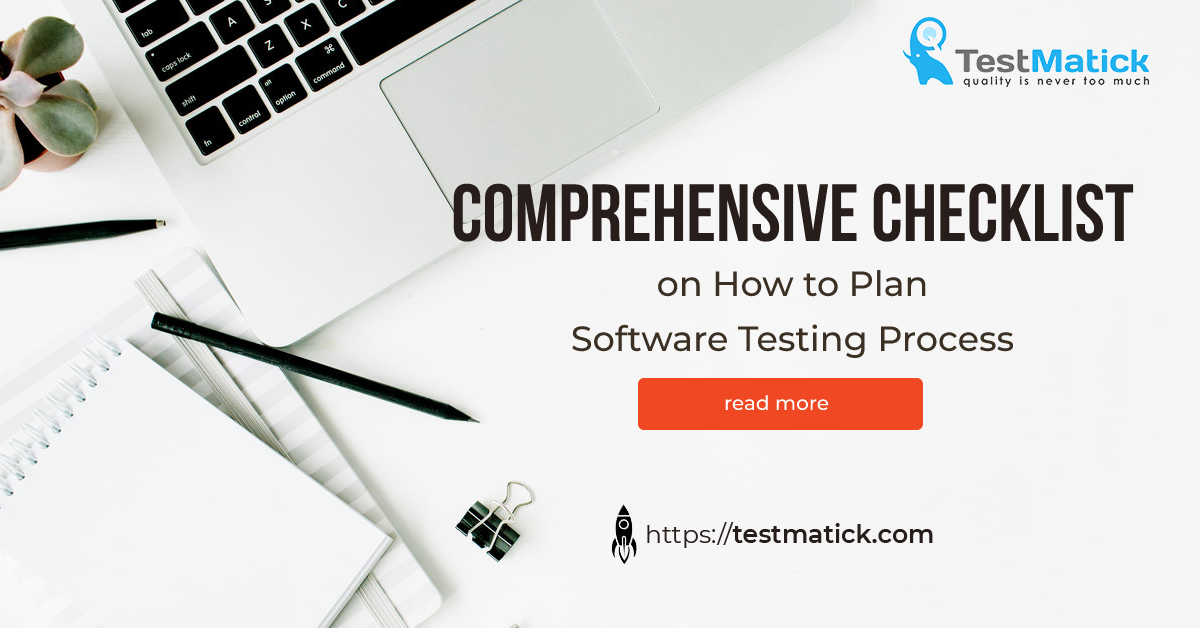Have you ever had a task to plan the testing process identifying all the subparagraphs? Have you ever felt that you’ve missed something? Were you worried about incorrect software functioning and that the reason for that was your unqualified testing?
With the checklist presented below, even a junior tester can handle anxiety and improve his/her strategy of software testing!These strategies cannot be considered a one-size-fits-all solution. Such methods are used to make a tester think during the working process. Thus, the QA engineer will be able to identify potential bugs correctly and will be like an accelerator of new software testing approaches.
No doubt, this cannot cover all the tests that may be needed on a project. But this is a correct way to think and thoroughly analyze a product under test.

Software Testing Planning Checklist
Software Testing Planning
Understand Why This Is Needed
There is no use to plan software testing if you aren’t sure about its reason. First of all, you need to answer the following questions.
- What are the purposes of software testing?
- Why is it you who should test this product?
- What are the standards of quality that need to be achieved?
- Were the goal and mission of testing agreed?
- How can one find major problems in software performance?
- Who do testers need to account for the test results?
- Who is interested in qualitative testing and how to meet their demands?
- What are the project risks?
- How cost-efficient is a test plan?
- What are the expected test results?
- When will the testing be completed?
- Is a tester ready for common administrative and practical delays?
Results of Software Testing
What are the testing results? If you use the Agile methodologies, it will be difficult to physically show the testing results.
- Actual test plans and strategies;
- Test cases;
- Types of defects;
- Results of exploratory testing and used notes;
- Conversations;
- Relevant documentation;
- Software updates.
Types of Testing
Types of testing will help to see what type exactly should be performed. Most testing plans cannot cover all these checks entirely. Testing plans can include the following items:
- Automated testing;
- Performance testing;
- Load testing;
- Functional testing;
- UI testing;
- Security testing;
- Scenario testing;
- User acceptance testing;
- Alpha and Beta testing;
- Prototype testing;
- Pair testing;
- Evaluation testability;
- Content testing;
- Regression testing.
Formats for Test Plan
No doubt, it is worth to know how to test the product according to a particular plan. Here, one can use the following:
- Written documentation;
- Mindmaps;
- Wikipedia;
- Spreadsheets;
- Checklists;
- Diagrams;
- Whiteboards;
- Sticky notes;
- Interactive whiteboard (for example, Trello);
- Kanban board.
Project Management
- Some plans change. Be ready for that!
- What technological business processes are used on a project?
- What is the most used system for test management?
- What is the communication system on a project?
- How do project members communicate?
- What can one get feedback on a project?
- How much time should everyday testing take?
- What is your daily schedule?
- When will the releases be?
- What specialists are available?
- Are there any factors that can block testing?
- What documentation is available?
- Which team members could you work with?
- With whom can you communicate and share the knowledge?
- Can you teach low-qualified employees how to test?
- What can you learn from others to improve the testing process?
Resources
Every testing step needs some resources, one way or another. Do you know what resources particularly you have access to? It is worth thinking about such simple things as:
- Test environment;
- Online platforms;
- Testing tools;
- Bug tracking systems;
- Test management tools;
- Test data library.
People
- Test team;
- Users;
- Project team;
- Eternal consultants;
- End users.
Data
- Documentation;
- Requirements;
- User guides;
- Web resources;
- Product history;
- Business laws and organization of the testing process;
- Social networks;
- User feedback.
Software Interpreting
You should always understand what the components of the tested product are.
How Does Software Work?
- Do you understand the logic of user interaction with software?
- Do you know the structure of the software?
- How well do you know the software functions?
- The platform – what online medium is it designed for?
- Information – what does it give? What functional states can it exist in?
Use of Testing Skills
- List of oracles and heuristics that are used for testing.
- How to achieve full test coverage?
- You should test like a tester-user. Do everything that clients never do.
- How to use automation to simplify the interaction with a product?
- Is it necessary to divide the product into the components?
- Features.
- Test stories.
- Modules.
- Classes.
- Design.
- Tools.
- Organizational vision.
Potential Risks
- What unexpected circumstances can cause an issue?
- How can the product become vulnerable?
- What is a reason (or technical basis) of the product malfunction?
- What are the risks and how to protect against them?
What Can Software Do?
- What can users do with software?
- Who will be the users of this software?
- What cannot the users do exactly?
Software Use
- Who are users?
- What are users’ stress cases?
- What will be the system environment of the product?
- How and when will the software be used?
- What negative scenarios can occur?
- What malicious actions can the product be vulnerable to after the release?
- What bugs were detected during testing and is it possible to arrange them?
To Sum Up
As we see, there is a big list of requirements that a tester should pay attention to during software testing. But if you have an effective plan for this purpose, your software testing and validation will be at a very high level. As we all know, QA as a service is the only thing that can protect a client from a large number of bugs and technical defects.










Leave A Comment